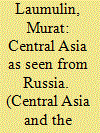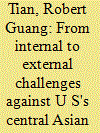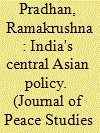| Srl | Item |
| 1 |
ID:
118758


|
|
|
|
|
| Publication |
2012.
|
| Summary/Abstract |
This is a survey of what has been written in Russia about Central Asia, of the subject range and scope of problems that our Russian colleagues have discussed in their works, and of what they think about the region's future. For obvious reasons, the Russian public as a whole and political scientists and politicians as its part cannot remain indifferent to what is going in Central Asia. Until quite recently, Russia and Central Asia were parts of a single state; today they remain tied together by geographic and geopolitical proximity. For these reasons, the region is still part of Russia's information expanse.
The Russian Federation, which has scored quite a few foreign policy successes, is still facing old and persisting problems and is coping with the new challenges that crop up in the contemporary world. The integration initiatives formulated by Russia are hailed by some of its post-Soviet partners and rejected (or even undermined) by others.
|
|
|
|
|
|
|
|
|
|
|
|
|
|
|
|
| 2 |
ID:
088549


|
|
|
|
|
| Publication |
2009.
|
| Summary/Abstract |
With the 9/11 event as the baseline, America's awareness of the strategic importance of Central Asia and the latter's weight in the U.S. global strategy was greatly changed. According to Charles Manes, the 9/11 terrorist attack enabled the U.S. to "discover Central Asia." This attack has straightened out the uncertainty due to confusion within the U.S. Government about the importance of the Central Asian area to the U.S. and enabled the U.S. to suddenly realize the important advantage of the five Central Asian nations in the global geopolitical pattern. However, the sympathy of the Central Asian nations, Russia and China for the U.S. on the terrorist attack and the warm help from the Central Asian nations to U.S.'s Taliban attacks in Afghanistan and to the U.S. military actions against al-Qa'eda, facilitated the U.S. army in Central Asia to gain the Manas Air Base and the Karshi Khanabad Airport (also called K2 Base). This symbolized a turning point for the U.S. to access the Central Asian area in one stroke. By stationing in Central Asia, the U.S. became a remarkably important power in Central Asia and nearby
|
|
|
|
|
|
|
|
|
|
|
|
|
|
|
|
| 3 |
ID:
153153


|
|
|